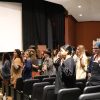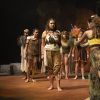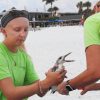A manatee named Eckerd is swimming off the coast of Cuba, a satellite tracking its every move.
The manatee tracking effort was one of several research projects by 10 Eckerd marine science students and Professor William A. Szelistowski during a two-week trip to Cuba this month.
Working with scientists and students from the University of Havana, the group studied and assessed the marine environment of coral reefs, captured and dissected Lionfish, studied tarpon and collected numerous fish specimens to help scientists document the diversity of the marine life near the Isle of Youth.
The group spent six nights on the 60-ft. Research Vessel Felipe Poey and another week conducting research closer to shore. “We basically did everything we set out to do,” said Szelistowski.
But the manatee research was a highlight. Manatees are a protected species in Cuba, just as they are in Florida, but manatee research is still in its infancy. This was only the third or fourth Cuban manatee to be tracked by satellite, Szelistowski said, which will give scientists a far clearer picture of how far the mammals roam and where they feed.
While the greatest threat to manatees in Florida is deadly collisions with boats, that is not the case in Cuba, where few people own boats. Instead, the greatest threat is fishermen, who illegally capture and eat the gentle sea cows. The result is that manatees in Cuba are more wary of humans than they are in Florida.
The Eckerd group also collected Tarpon for one of the University of Havana’s research projects. The game fish has been popular in Florida for decades, generating millions of dollars in economic impact, particularly in Boca Grande on Florida’s Gulf Coast. Learning more about the habitat and species diversity will lay the groundwork for the future.
The work was overseen by Jorge Angulo, a marine scientist with the University of Havana and former director of its marine science center.
The group also spent time collecting and dissecting Lionfish, an invasive species that scientists fear are a threat to native reef fish. The students collected the fish, which are covered in venomous spines, in underwater boxes that Szelistowski designed and built. The students dissected the fish and removed the stomachs for examination to determine what they are eating.
Nearly all of the students were certified for scuba diving, and they used those skills to collect video images of the coral reefs, using double-camera gadgets owned by the University of Havana. The images were sent to the university for study to better understand the diversity of the species living along the reefs, which are in much better condition than the coral reefs in the Florida Keys.
They also used a seine net to collect fish as part of on-going research that will be put into a guide to the fish in the area.
The Isle of Youth was once known as the Isle of Pines and home to a prison where Fidel and Raul Castro were held after they were captured for attacking the Moncada Barracks in Santiago de Cuba. The Eckerd group took a day trip to see the prison, which includes a small museum about the Castros’ imprisonment.
The students who accompanied Szelistowski were: Nicole Armstrong ‘17, Jillian Calabro ‘16, Will Demarest ‘15, Takoda Edlund ‘16, Erika Fridrik ‘15, Rachael Kalin ‘16, Sean Laughlin ‘16, Mitch Lemon ‘16, Tanner Morris ‘15 and Connor Zink.












